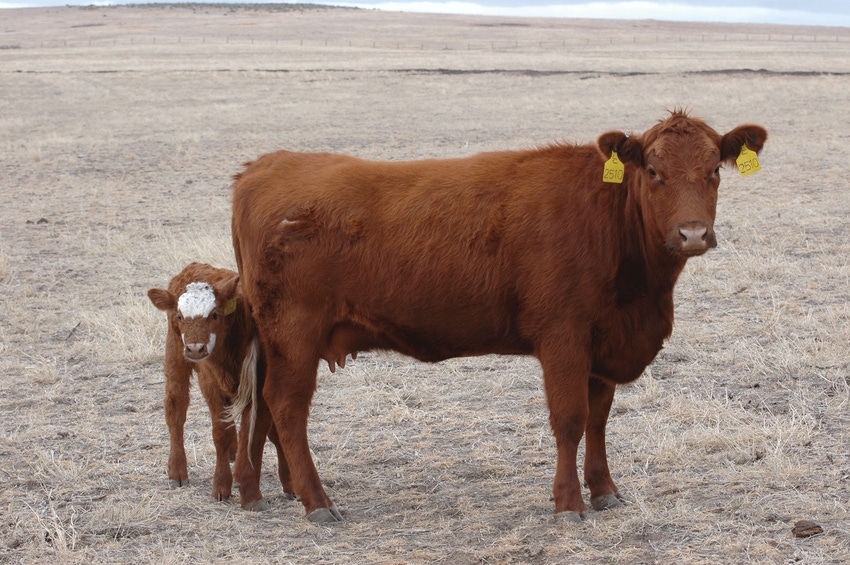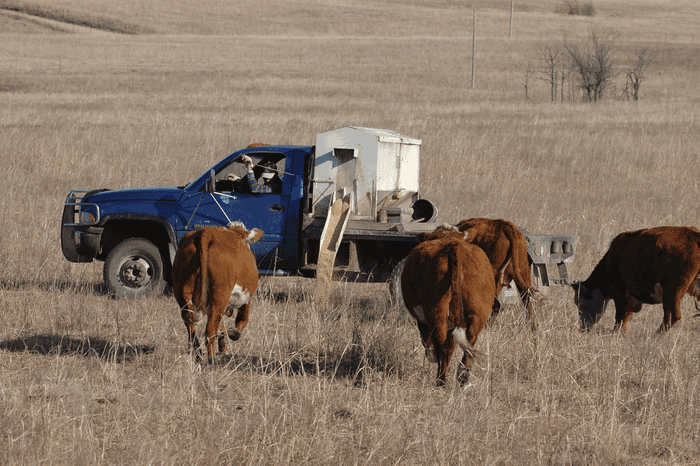Best practices for managing cows on pastures with limited forages
Drought has cut hay supplies and pasture in many parts of the country. Here’s a look at how to manage your cows this winter.
October 30, 2018

By Jaymelynn Farney
It could almost be called a perfect storm. Except the drought that plagued much of the country, including the Great Plains, lacked one important element — storms.
While rains have come to parts of the parched landscape, in most cases they came too late to help this year’s grazing season. As a result, beef producers in drought areas are looking at another winter with limited hay supplies and grazing availability.
Through last winter, there were producers who fed more hay than is typical, and that has used up a significant amount of hay reserves. Given all these factors, cattle producers need to find alternative feedstuffs to maintain current cow numbers. Here are a few ideas.
Swap hay for high-energy feed
Feeding a starchy feed such as corn is an option in cow-calf operations. Generally, we consider this a “no-no” for the cow operation, as it can potentially inhibit voluntary forage intake.
Traditionally, grass is the cheapest commodity and the resource that producers want to use to the greatest extent. However, in limited-forage situations, the cost per unit of energy may favor use of corn or other high-energy feeds.
We do need to be aware of the substitution effect that comes into play when doing so. Some report that feeding corn to cows at less than 0.3% of body weight will have limited impact on voluntary hay intake and fiber digestion. Offering corn at levels greater than this can result in reductions in fiber digestion and hay intake. At certain proportions, adding corn to the diet could reduce total energy intake.
Nutrition and Extension professionals can develop a feeding program that determines how much corn and how much harvested forage should be offered to meet performance objectives.

Using alternative byproduct feeds like distillers grain, or grazing cattle on cornstalks or other crop residue, can be a lower-cost option when hay is short — at least for those beef producers who are close enough to those options to make them work. As you’re searching for ways to get your cattle through the winter on short pastures, keep a sharp pencil handy, and run the figures closely.
Correctly balancing the diet can result in feeding less hay to the cows, thus extending the forage supply. To develop a more accurate feeding strategy, a forage analysis will be beneficial.
The following is an example of how to stretch your hay by feeding a high-energy feedstuff such as corn. Assume your hay is 8% crude protein and 46% total digestible nutrients (TDN), and corn averages 8% crude protein and 88% TDN — all dry matter basis. For each pound of corn fed, you can feed 1.9 pounds less hay to achieve a diet that has the same protein and energy as hay alone.
Another thing to think about is there are some high-energy and high-protein byproduct feeds that can be used as a substitute for hay. These are often a preferred feed over corn because of reduced bloat and acidosis potential, since the starch has been removed.
Limit feeding
Nutrient-dense diets can be fed to cows, especially if limiting the total amount offered to meet but not exceed requirements. Typically, cows on a high-quality forage can easily consume 2.5% of body weight (on a dry matter basis) daily.
If cows are in good flesh prior to the start of feeding, the goal would be to maintain, not gain, weight. Thus, feeding a primarily silage ration at 1.8% of body weight could meet cow requirements while extending feed resources.
When limit-feeding cows the first couple of weeks, you will think that they are losing weight. These cows will appear gaunt as compared to full feed on pasture. If you run them across the scale, they will also weigh considerably less. The difference in weight is purely based on rumen fill. Monitor body condition score to evaluate if the ration is meeting goals.
Other things to consider when limit feeding cows are that cows will be hungry, and all cows will want and need to eat at the same time. Thus, a minimum of 24 inches of liner bunk space needs to be provided.
Cows should be fed at the same time each day. High-energy, limit-fed diets require little time for consumption and leave many hours in the cow’s day to find trouble. These cows could also be somewhat more vocal and might do some moderate damage to the facilities, driven by boredom.
When limit-feeding cows, make sure to mix the salt, mineral and vitamins into the ration. Do not offer free choice, because they will overconsume.
Ionophore use
Ionophores are a feed antibiotic (veterinary feed directive not required) that alters the rumen microbes to generate higher-energy metabolites to the animal.
This improvement in efficiency has been demonstrated by research conducted at Oklahoma State University, where cows maintained the same body condition on 10% less hay when consuming an ionophore, compared to cows that did not receive the ionophore.
Ionophores are cheap, costing roughly 2 cents per head per day, and they improve feed efficiency. At this time, Rumensin is the only ionophore that is approved for use in reproducing cows.
Assess by body condition, needs
Sorting cows by need will minimize over- and underfeeding. If you have the space, place all thin cows and cows with a high nutrient demand (pregnant replacement heifers, early-lactation cows) in the same location, and offer these cows a more nutrient-dense diet.
The cows that are in adequate body condition and just need to maintain weight can be fed either a less nutrient-dense diet that is cheaper or the same nutrient-dense diet at a restricted amount — whichever is most economical. This approach will increase the overall feed efficiency and result in less waste (overfeeding the fatter cows).
Annual forages
With the late summer and early fall moisture, producers may have been able to plant small grains and brassicas for fall to early winter grazing. If planted prior to Sept. 15, there may be sufficient growth to offer some relief to perennial cool-season pastures. All of these fall and winter annuals are high-energy and -protein feeds that more than exceed a dry pregnant cow’s maintenance requirements.
Strip-grazing and limit-grazing these annuals can increase the stocking density on the paddock and can stretch the grazing days. The annuals that seem to grow the fastest for fall and winter grazing include oats, barley, and all the brassicas (e.g., turnips, radishes, rape). Annual forages are not a silver bullet when other forage resources are limited since they still require moisture, and an early freeze can severely inhibit growth.
A few other options to consider include:
Limit access to hay. Some studies have shown that you can remove cows from hay for 12 hours a day, and they will consume less hay and maintain the same condition as cows with free-choice access.
Consider hay feeder type. This can have significant effects on the amount of hay wasted, thus reducing the number of bales that go through a feeder and the time to clean up feeding sites.
Pregnancy-check, if you haven’t done so already. Make sure to remove cows that have no chance of producing a calf in the short term. Feeding open cows can be very expensive if you have limited resources.
Make strategic culling decisions.
As you are making the tough decisions, it will help to have accurate estimates of the available resources, costs, feed analysis and labor restrictions. Not all of these options will work in every operation, but being willing to do an in-depth evaluation of your capabilities will help you determine what works for you. Take advantage of the resources provided by your local Extension unit, nutritionist and state Extension specialist to help evaluate resources to maintain your cow herd.
Farney is an Extension beef systems specialist with Kansas State University who is headquartered in Parsons, Kan.
You May Also Like


.png?width=300&auto=webp&quality=80&disable=upscale)
